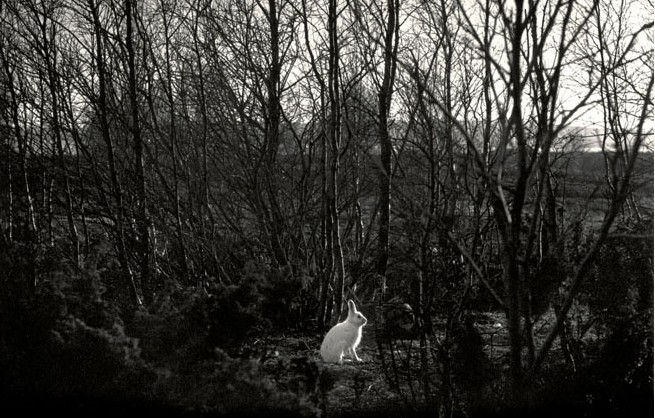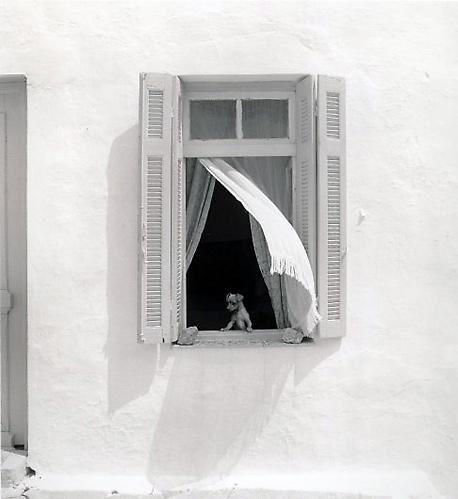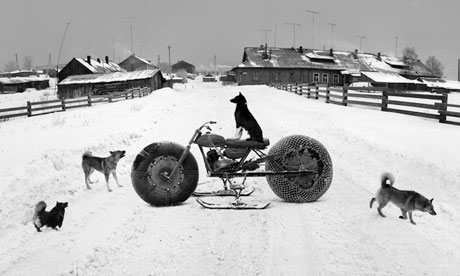
Here Far Away – Pennti Sammallahti’s Nomadic Photographs
In 1991 the Scandinavian photographer, Penti Sammallahti, was awarded a 15-year grant from the Finnish government to go do what he does best—travel and take photographs. His recent exhibition at Photo-Eye Gallery (December 7—February 9) is the culmination of Sammallahti’s past 15 years as well as honors the recently published retrospective book, Here Far Away. The book spans forty years of his career and documents 175 photographs from countless cities.
Photo-Eye shows about 60 silver gelatin prints, salon-style, in its gallery on Garcia Street. The photos are small and intimate—some four-by-five-inches, some tall and skinny like the landscape Mont Llia, Pays de Galles (1991) that’s 14×6 inches. One gets the feeling that Sammallahti is very purposeful about his printing. Each image is cropped effortlessly within perfect dimensions and preened to a flawless surface. Indeed, the Finnish artist, who prints in his studio in Helsinki, is known for his eye as well as his darkroom craftsmanship.

Sammallahti is nomadic, and his whereabouts can probably best be charted not by a cell phone but by following the trail of his photographs. In 1973, Sammallahti was 23 years old and off the coast of Finland photographing the island of Jurmo. A 6×7 inch print in 1975 places him in Hydra, Greece. The image shows an adobe white wall cut into by a quaint shuttered window. It is centered and shadows cast by the window and billowing curtain suggest a high sun. Perched and ready for action, the tiniest of toy dogs sights something important outside. Its endearing examination from the windowsill is only visible to us because at that very moment, the curtain blew out to the side, exposing this little creature.

Undoubtedly full of adoration for canines, a snowy scene in Solovki, Venaja, Russia in 1992 captures a dog so statuesque it photographs like a mock equestrian statue. Its black profile roosts on the human seat of a home-modified snow mobile sitting stationary in the middle of the road. There are no humans in this scene but three other dogs, two of which bark in disdain at their protagonist.
In Kathmandu, Nepal 1994, Sammallahti photographed front and center a stray dog curled directly beneath a Buddha shrine. The scene is centered with stone architecture neutralizing the background. The dog’s perky triangular ears respond on high, and the dog looks up at the statue in inquiry and near reverence. The canines (and other animals) wandering the streets in these countries become magically anthropomorphized and narrated by Sammallahti’s lens. This Kathmandu dog wants to pray.

Back home in Helsinki in 2002, Sammallahti spotted a precarious tree with a large branch balanced perfectly horizontal through the standing tree. A bird perches on either side as if playing seesaw. It is a cold blistery scene with white sky and misted grey, barren trees behind. The two trees form a rustic cross that fills the 6.5×8 inch image completely. Like Sammallahti’s above images, this one is not without humor. Two birds on either side, talking? playing phone? They are given fairy-tale powers and the whimsies of nature, and of its relationships, become sentient in themselves. This is the magic of Sammallahti’s eye and craftamanship.
Henri Cartier-Bresson chose Sammallahti as one of his favorite 100 photographers for his Foundation’s inaugural exhibitions in Paris in 2004. Sammallahti’s work even carries some similarities but where Bresson photographed fast paced street scenes with a 35mm, Sammallahti photographs bucolic life, often shooting in medium format. And so, the Scandinavian’s photographs reflect a slower pace, a more contemplative mood and far fewer humans than animals.

